Rhamnous
Rhamnous (Greek: Ῥαμνοῦς), also Ramnous or Rhamnus, was an ancient Greek city in Attica situated on the coast, overlooking the Euboean Strait. Its impressive ruins lie northwest of the modern town of Agia Marina in the municipality of Marathon.
Ραμνούς | |
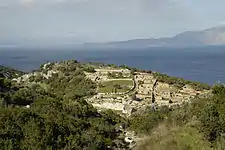 View of the site of Rhamnous with Euboea in the background | |
 Shown within Greece | |
| Alternative name | Ramnous, Rhamnus |
|---|---|
| Location | Agia Marina, Attica, Greece |
| Region | Attica |
| Coordinates | 38°13′24″N 24°1′38″E |
| Type | Settlement |
| History | |
| Periods | Hellenistic |
| Satellite of | Athens |
| Site notes | |
| Condition | Ruined |
| Ownership | Public |
| Management | 2nd Ephorate of Prehistoric and Classical Antiquities |
| Public access | Yes |
| Website | Ramnous |
The site was best known in antiquity for its sanctuary of Nemesis,[1] the implacable avenging goddess, her most important in ancient Greece.
Rhamnous is the best-preserved Attic deme site. It was strategically significant on the sea routes and was fortified with an Athenian garrison of ephebes (young men). A fortified acropolis dominates the two small harbours located on either side of it which have silted up extensively since antiquity, and into which grain was imported for Athens during the Peloponnesian War.
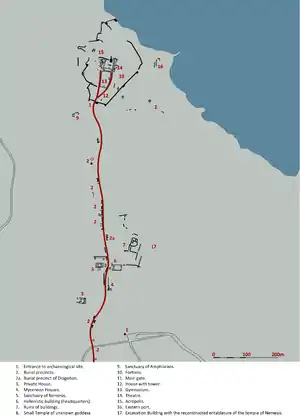
History
Rhamnus or Rhamnous (Ancient Greek: Ῥαμνοῦς) or Rhamnuntus or Rhamnountos (Ῥαμνοῦντος) was a deme of ancient Attica, belonging to the tribe Aeantis.[2][3] It derived its name from a thick prickly shrub, which still grows upon the site. The town stood upon the eastern coast of Attica, at the distance of 60 stadia from Marathon, and upon the road leading from the latter town to Oropus.[1] It is described in the Periplus of Pseudo-Scylax as a fortified place;[4] and it appears from a decree in Demosthenes[5] to have been regarded as one of the chief fortresses in Attica. It was still in existence in the time of Pliny the Elder.[6]
Rhamnus was the birthplace of the orator Antiphon; but it was chiefly celebrated in antiquity on account of its worship of Nemesis, who was hence called by the Latin poets Rhamnsusia virgo and Rhamnsssia dea.[7] The temple of the goddess was at a short distance from the town.[1] It contained a celebrated statue of Nemesis, which, according to Pausanias, was the work of Pheidias, and was made by him out of a block of Parian marble, which the Persians had brought with them for the construction of a trophy. The statue was of colossal size, 10 cubits in height,[8] and on its basis were several figures in relief. Other writers say that the statue was the work of Agoracritus of Paros, a disciple of Pheidias.[9][10] It was however a common opinion that Pheidias was the real author of the statue, but that he gave up the honour of the work to his favourite disciple.[11]
Rhamnus stood in a small plain, 3 miles (5 km) in length, which, like that of Marathon, was shut out from the rest of Attica by surrounding mountains. The town itself was situated upon a rocky peninsula, surrounded by the sea for two-thirds of its circumference, and connected by a narrow ridge with the mountains, which closely approach it on the land side.
It was about half a mile in circuit, and its remains are considerable. The principal gate was situated upon the narrow ridge already mentioned, and is still preserved; and adjoining it is the southern wall, about 20 feet (6.1 m) in height. At the head of a narrow glen, which leads to the principal gate, stand the ruins of the temple of Nemesis upon a large artificial platform, supported by a wall of pure white marble. But we find upon this platform, which formed the temenos (τέμενος) or sacred enclosure, the remains of two temples, which are almost contiguous, and nearly though not quite parallel to each other. The larger building was a peripteral hexastyle, 71 feet (22 m) long and 33 feet (10 m) broad, with 12 columns on the side, and with a pronaus, cella, and posticum in the usual manner. The smaller temple was 31 feet (9.4 m) feet long by 21 feet (6.4 m) feet broad, and consisted only of a cella, with a portico containing two Doric columns in antis. Among the ruins of the larger temple are some fragments of a colossal statue, corresponding in size with that of the Rhamnusian Nemesis; but these fragments were made of Attic marble, and not of Parian stone as stated by Pausanias. It is, however, not improbable, as William Martin Leake, who visited the site in the early 19th century, has remarked, that the story of the block of stone brought by the Persians was a fable, or an invention of the priests of Nemesis by which Pausanias was deceived. Among the ruins of the smaller temple was found a fragment, wanting the head and shoulders, of a statue of the human size in the archaic style of the Aeginetan school. This statue is now in the British Museum. Judging from this statue, as well as from the diminutive size and ruder architecture of the smaller temple, the latter appears to have been the more ancient of the two. Hence it has been inferred that the smaller temple was anterior to the Greco-Persian War, and was destroyed by the Persians just before the Battle of Marathon; and that the larger temple was erected in honour of the goddess, who had taken vengeance upon the insolence of the barbarians for outraging her worship. In front of the smaller temple are two chairs (θρόνοι) of white marble, upon one of which is the inscription Νεμέσει Σώστρατος ἀνέθηκεν, and upon the other (Θέμιδι Σώστρατος ἀνέθηκεν, which has led some to suppose that the smaller temple was dedicated to Themis. But it is more probable that both temples were dedicated to Nemesis, and that the smaller temple was in ruins before the larger was erected. A difficulty, however, arises about the time of the destruction of the smaller temple, from the fact that the forms of the letters and the long vowels in the inscriptions upon the chairs clearly show that those inscriptions belong to an era long subsequent to the battle of Marathon. Christopher Wordsworth considered it ridiculous to suppose that these chairs were dedicated in this temple after its destruction, and hence conjectures that the temple was destroyed towards the close of the Peloponnesian War by the Persian allies of Sparta.[12]
Monuments
Understanding of the history of Rhamnous was greatly improved by the work of Jean Pouilloux,[13] who studied the fortress and the inscriptions from the site.
The sanctuary of Nemesis
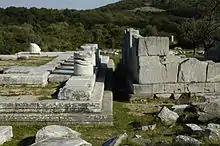
The sanctuary of Nemesis lies on the road between Rhamnous and Marathon, around 630m south of the later city.
Two temples to Nemesis and Themis can be seen at the site situated very close together.
In modern times, John Peter Gandy's[14] admirable work to document the site was the first in 1813. As a pioneer in a discipline then in its infancy, Gandy recorded in his notes and drawings much information which would otherwise be lost, since the temples in the sanctuary were much better preserved then.
Small Temple
The earliest temple dates from the late 6th century BC, made of Poros stone and known from a few Laconian roof tiles, which was probably destroyed by the Persians in 480-479 BC.
In the early 5th BC the small temple (6.15 by 9.9m) of a 6 × 12 Doric order was built over the earlier remains to both the goddesses Themis and Nemesis, indicated by dedicatory inscriptions on two marble seats of the 4th century BC that were sited on the porch. The former was the personification of Right Order and the latter the avenger of Order's transgressors.
There are several cuttings on the steps of this temple for the insertion of stelai. The temple was built of local dark marble and roofed with terracotta tiles. The walls of the cella and the terrace of the sanctuary platform are built in the Lesbian polygonal style of masonry. This temple probably served later as a treasury of the large temple for its cult statues.
A statue of Themis and several other dedications, unearthed in the cella, are at the National Archaeological Museum, Athens.
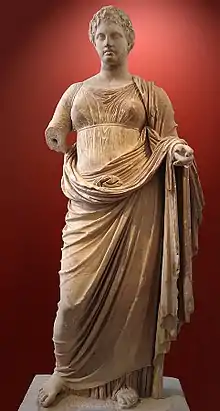
This structure survived until the 4th century AD.
Large Temple

Construction of the larger temple to Nemesis[15] began around 460-450 BC and continued until 430–420. It was built as a Doric peripteral temple during the reign of Pericles when the Parthenon was built in Athens, and on a platform with a massive polygonal terrace wall. It is believed that it was designed by the architect Callicrates who designed the Temple of Hephaestus in Athens, the Poseidon Temple at Cape Sounion and the Ares temple in Acharnes.
The euthynteria and lowest level of the crepidoma were made from local dark marble, while the rest was constructed of white marble.
The Peloponnesian War must have interrupted the completion from 431 BC and carving of the column flutes was not done and the stylobate blocks were left unfinished, retaining the protective excess marble on their easily damaged corners and upper surfaces. There were no pedimental sculptures, nor were the metopes decorated with sculpture. The roof was decorated with sculptural acroteria, however.

At some point after the original construction, the Temple of Nemesis was severely damaged at its eastern end and the upper courses were subsequently repaired with new blocks. The damage to this and other temples in the region and the destruction of monuments in Athens is thought to be caused by the armies of Philip V of Macedon during his raids in 200 BC. The blocks which were used to repair the Temple of Nemesis are distinct from the original blocks and the tooling is quite different which suggests that the repairs were made in the Roman period, when interest in the old Classical temples was renewed. The central block of the architrave on the east end of the temple bears an inscription of rededication to the goddess Livia by the Demos, which may be associated with the repairs. This reconstruction must have been costly since it involved replacing the east end, which required making duplicate blocks for the frieze, geison, perhaps the tympanon, the raking geison, the akroteria, and perhaps part of the sima, rooftiles, and ceiling coffers. Unlike other temples in Attica which had fallen into disrepair, the Temple of Nemesis was not stripped of useful parts or removed whole to Athens. Instead, it was restored with pride as an important local monument.
Statue of Nemesis
The cella of the large temple housed the cult figure of Nemesis, sculpted by Agorakritos, a pupil of Phidias, from the block of Parian marble alleged to have been brought by the overconfident Persians for their triumphal stele.[1] This famous statue[16] of the goddess stood within the cella of the temple and was around 4m high. The Roman historian and connoisseur Varro rated it the finest example of Greek sculpture.
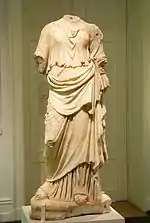
The badly damaged remains of an over life-size marble head from a cult statue of Nemesis, with perforations for attaching a gold crown, was discovered by the British architect John Gandy in the early nineteenth century and is now part of the British Museum's collection.[17] This has a stylistic similarity to the pediment sculptures of the Parthenon of 440-432 BC.
Many parts of the original statue have been recovered and reconstructed[18][19] from the hundreds of fragments found scattered about after the destruction of the cult image by early Christians, and this allowed the identification of a total of eleven Roman copies on a smaller scale. The base of the statue, approximately 90 cm high and 240 cm wide, has also been reconstructed; on three sides of the base, the nearly-in-the-round scene shows the presentation of Helen to her mother Nemesis by Leda.[20]
Roman Period
In the Roman period c. 46 AD, dedications were made at the sanctuary to the deified Livia, the wife of Augustus, and to the emperor Claudius. In the 2nd century AD, Herodes Atticus made dedications of busts of the emperors Marcus Aurelius and Lucius Verus as well as a statue of his pupil Polydeucion. The cult of Nemesis at Rhamnous came to a formal end with the decree of the Byzantine emperor Arcadius in 382 AD that ordered the destruction of any surviving polytheist temples in the countryside.[21]
Rhamnous deme site

The fortified acropolis of Rhamnous occupying a c. 28m high hill of area approximately 230 by 270m. The fortification walls were constructed of the local marble from Agia Marina. There were also significant numbers of buildings outside the walls of the fortified area.
Many grave monuments have been recovered from burials along the road between Rhamnous and Marathon.
Images
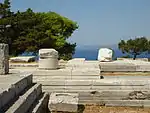 Temple of Nemesis
Temple of Nemesis Temple of Nemesis
Temple of Nemesis General view of Rhamnous
General view of Rhamnous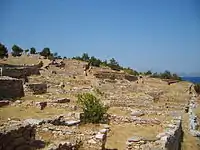 Closer view
Closer view Main path
Main path
Notes
- Pausanias. Description of Greece. 1.33.2.
- Stephanus of Byzantium. Ethnica. s.v.
- Harpocr., Suid., s. v.
- Periplus of Pseudo-Scylax, p. 21.
- Demosthenes, pro Cor. p. 238, ed Reiske.
- "Rhamnus pagus, locus Marathon," Pliny. Naturalis Historia. 4.7.11.
- Catull. 66.71; Claud. B. Get. 631; Ovid Met. 3.406, Trist. 5.8.9; Stat. Silv. 3.5.5.
- Hesych. sub voce; Zenob. Prov. 5.82.
- Strabo. Geographica. ix. p.396. Page numbers refer to those of Isaac Casaubon's edition.
- Pliny. Naturalis Historia. 36.5.4-17.
- Suid. s.v. Zenob. Prov. 5.82; Tzetz. Child. 7.960.
- William Martin Leake, Demi of Attica, p. 105, et seq., 2nd ed.; Northern Greece, vol. ii. p. 434, et seq.; Christopher Wordsworth, Athens and Attica, p. 34, et seq.; Unedited Antiquities of Attica, c. vi. p. 41, et seq.
- Jean Pouilloux, La Forteresse de Rhamnonte : étude de topographie et d'histoire, Bibliothèque des Écoles françaises d'Athènes et de Rome, de Boccard, Paris, 1954.
- "The Unedited Antiquities of Attica", London 1817, and Antiquities of Ionia, Part V (Suppl. to Part III), W. R. Lethaby,ed., London 1915
- "Reconstruction of the Temple of Nemesis at Rhamnous", M. Miles, American School of Classical Studies at Athens, Hesperia Vol. 58, No. 2, https://www.jstor.org/stable/148334
- Pliny's Natural History Pliny 36.17.
- British Museum Collection
- "Nemesis" Penn Museum, Expedition Magazine 15.1 (September 1972) <http://www.penn.museum/sites/expedition/?p=2380>http://www.penn.museum/sites/expedition/nemesis/
- Despinis, G. "Discovery of the Scattered Fragments and Recognition of the Type of Agorakritos' Statue of Nemesis." AAA 3 (1970), 403-414.
- Lapatin, K.D.S. "The Reconstruction of the Temple at Rhamnous? Who is who on the Nemesis Base?", The Journal of the American School of Classical Studies at Athens, Hesperia 61 (1992), 107-119, https://www.jstor.org/stable/148185
- Si qua in agris templa sunt, sine turba ac tumultu diruantur. His enim deiectis atque sublatis omnis superstitioni materia consumetur., Codex Theodosianus,Liber XVI,X.16
![]() This article incorporates text from a publication now in the public domain: Smith, William, ed. (1854–1857). "Rhamnus". Dictionary of Greek and Roman Geography. London: John Murray.
This article incorporates text from a publication now in the public domain: Smith, William, ed. (1854–1857). "Rhamnus". Dictionary of Greek and Roman Geography. London: John Murray.
References
- Despinis, G. "Discovery of the Scattered Fragments and Recognition of the Type of Agorakritos' Statue of Nemesis." AAA 3 (1970), 403–414.
- Dinsmoor, W.B. Jr. "Rhamnountine Fantasies," Hesperia 30 (1961), 179–204.
- Edwards, C.M. "Tyche at Corinth," Hesperia 61 (1990), 529–542.
- Hodge, A.T. and R.A. Tomlinson. "Some Notes on the Temple of Nemesis at Rhamnous," AJA 73 (1969), 162–185.
- Karusu, S. "Ein Akroter klassischer Zeit" AthMitt 77 (1962), 178–190.
- Langlotz, E. "Eine Metope des Nemesistempel in Rhamnus" in Scritti in onore di Bartolomeo Nogara. Vatican City, 1937, 225–230.
- Lapatin, K.D.S. "The Reconstruction of the Temple at Rhamnous? Who is who on the Nemesis Base?" Hesperia 61 (1992), 107–119.
- Leake, William Martin. Travels in the Morea vol. II (London 1830)
- Miles, M.M. "The Reconstruction of the Temple of Nemesis at Rhamnous", Hesperia 58 (1989), 134-256.
- Oetjen, R., Athen im dritten Jahrhundert v. Chr. Politik und Gesellschaft in den Garnisonsdemen auf der Grundlage der inschriftlichen Überlieferung, Duisburg 2014.
- Petrakos, V. Rhamnous. Athens, 1991.
- Stillwell, Richard, ed. Princeton Encyclopedia of Classical Sites, 1976: "Rhamnous, Attica Greece"
- Thompson, H.A. "Athens Faces Adversity." Hesperia 50 (1981), 346–348.
- Travlos, J. Bildlexikon zur Topographie des antiken Attika. Tubingin, 1988, 388–403.
- de Waele, J.A.K.E. "The Design for the Temple of Nemesis at Rhamnous," in M. Gnade, ed., Stips Votive, Papers Presented to C.M. Stibbe. Amsterdam, 1991, 249–264.
- Wilhelm, A. "Themis und Nemesis von Rhamnous." OJb 44 (1942), 200–209.
External links
| Wikimedia Commons has media related to Rhamnous. |
